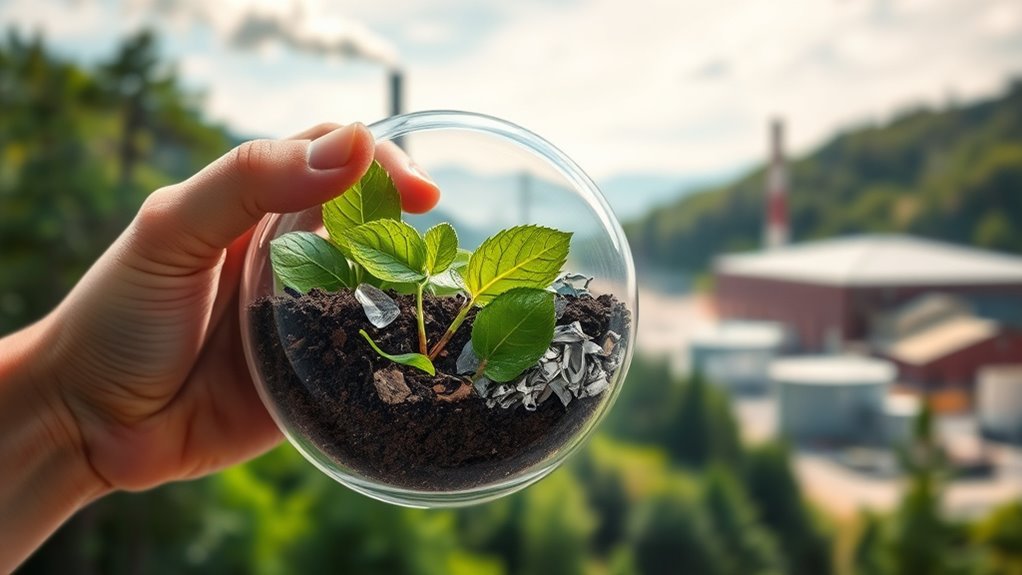A life cycle assessment helps you measure a product’s environmental impact by analyzing each stage from raw material extraction to disposal or recycling. It reveals hidden costs and environmental effects you might overlook at the final product stage. By considering every phase, you can identify opportunities to reduce waste, conserve resources, and make more sustainable choices. Keep exploring to understand how this holistic approach can inform smarter, eco-friendly decisions for products and processes.
Key Takeaways
- LCA evaluates a product’s environmental footprint across all stages, from raw material extraction to disposal.
- It identifies hidden impacts and resource use that are not visible at the final product stage.
- LCA supports eco design by highlighting opportunities to reduce waste, emissions, and energy consumption.
- It enables targeted improvements in manufacturing, distribution, and end-of-life processes for sustainability.
- Conducting LCA promotes responsible decision-making and helps develop greener, more sustainable products.

Have you ever wondered what goes into determining the true environmental impact of a product or service? It’s a complex process that requires looking beyond just the final product and considering every stage of its existence. This is where a life cycle assessment (LCA) becomes invaluable. An LCA helps you understand the full environmental footprint, from raw material extraction to disposal or recycling. It’s a thorough method that reveals hidden costs and impacts, empowering you to make more sustainable choices.
Discover how life cycle assessments reveal the true environmental impact of products from start to finish.
When conducting an LCA, you focus on each phase of a product’s life, starting with raw material acquisition. This stage often involves resource extraction, which can drastically affect ecosystems and deplete natural reserves. Next, manufacturing comes into play—a stage where sustainable manufacturing practices and eco design principles can greatly reduce environmental harm. By integrating eco design principles into your manufacturing process, you can minimize waste, reduce energy consumption, and select eco-friendly materials. This proactive approach not only benefits the environment but can also lower costs and improve your brand’s reputation. Additionally, considering material selection is crucial for reducing the overall environmental impact of the product.
As the product moves into distribution and use, the assessment continues, considering the energy needed for transportation and the environmental effects of the product during its usage phase. For example, energy-efficient appliances or products designed for durability and reparability contribute to a lower overall footprint. When it’s time for disposal or recycling, the assessment evaluates how easily the product can be repurposed or broken down, closing the loop on its environmental impact. Incorporating sustainable logistics can further reduce emissions associated with transportation and distribution. Moreover, understanding the full life cycle enables businesses to identify opportunities for eco-friendly innovations and process improvements. Recognizing the importance of life cycle stages can help companies target specific areas for improvement and innovation.
Incorporating eco design principles from the outset guarantees that sustainability is built into your product’s DNA. This means designing with recyclability, longevity, and minimal environmental impact in mind. Sustainable manufacturing isn’t just a buzzword; it’s an essential aspect of creating products that respect the planet’s limits. By applying these principles throughout the product’s life cycle, you reduce waste, conserve resources, and lower emissions. Understanding the environmental impacts through a life cycle assessment allows you to identify areas for improvement, innovate with greener options, and ultimately produce more sustainable products.
It’s also important to consider the role of environmental considerations like light pollution in the overall impact, especially for products and practices in outdoor settings. It’s about taking responsibility for every stage of a product’s life and making smarter, eco-conscious decisions. Whether you’re a manufacturer, designer, or consumer, recognizing the importance of these assessments helps you contribute to a healthier planet. Embracing sustainable manufacturing and eco design principles means you’re actively working toward reducing environmental harm while delivering high-quality, responsible products.
Frequently Asked Questions
How Accurate Are Life Cycle Assessments for New or Innovative Products?
You might wonder how accurate life cycle assessments are for innovative products. These assessments often rely on traditional metrics, which may not fully capture new processes or materials, leading to data uncertainty. While LCA provides valuable insights, its accuracy for innovative products can be limited due to evolving data and the lack of established benchmarks. Expect some variability, and consider supplementing assessments with innovative metrics to better understand environmental impacts.
Can LCA Results Be Standardized Across Different Industries?
Think of standardizing LCA results like fitting puzzle pieces from different boxes. You can’t always expect perfect alignment across industries, but using industry benchmarks helps improve data comparability. While standardization isn’t foolproof due to diverse processes and materials, establishing common frameworks and guidelines can make results more comparable, aiding stakeholders in better environmental decision-making across sectors.
What Are the Main Challenges in Collecting Lifecycle Data?
You face challenges in collecting lifecycle data, mainly due to data completeness and consistency issues. Completing all necessary data points can be difficult, especially for complex products or processes. Ensuring data consistency across different sources and stages is also tough, as discrepancies can skew results. These hurdles require diligent data management and standardized methods to accurately assess environmental impacts, helping you make informed decisions.
How Do LCA Methods Account for Social and Economic Impacts?
Ever wonder how LCA methods tackle social and economic impacts? They dive beyond environmental factors by including social metrics like labor practices and community well-being, which can be tricky to quantify. They also use economic valuation techniques to assign monetary values to these impacts, making them comparable. This way, your assessment becomes more all-encompassing, revealing the true footprint of a product on society and the economy.
Are There Any Legal Requirements for Conducting LCAS in Certain Regions?
You should know that in some regions, there are legal requirements for conducting LCAs to guarantee regulatory compliance. Many countries have established legal frameworks that mandate environmental impact assessments for specific products or industries. These laws aim to promote sustainable practices and transparency. If you operate in such regions, you’ll need to follow these legal frameworks carefully, ensuring your LCAs meet all regional standards and regulations to avoid penalties or legal issues.
Conclusion
By understanding the full life cycle of a product, you realize how each step impacts our planet—sometimes in surprising ways. It’s almost like uncovering a hidden story behind everyday items, revealing how your choices ripple through the environment. When you start paying attention to these details, you might find yourself making more mindful decisions, unknowingly contributing to a healthier Earth. Sometimes, the smallest actions can lead to the biggest changes—just like discovering a hidden chapter you never knew existed.










